Limited bathroom square footage doesn’t have to mean limited style or function. With the right layout tricks and smart design choices, even the tiniest showers can feel practical, polished, and surprisingly luxurious. From corner units to frameless glass and clever tile placements, small-space solutions can dramatically improve both form and flow. These modern ideas are crafted to help homeowners make the most of compact spaces—without expensive renovations or sacrificing comfort. Whether you’re planning a full remodel or just need creative upgrades, the sections ahead are packed with space-saving strategies and visual inspiration designed specifically for today’s small bathrooms.
Tile Drenching

Saturating every surface with the same tile creates a powerful illusion of expansiveness. When floor, walls, and ceiling are coated in a single material, visual breaks vanish—an instant trick to make even the smallest shower feel enveloping and sleek. This method isn’t just aesthetic; it offers functionality through fewer grout lines and easy maintenance. Whether you’re leaning into porcelain, ceramic, or even marble, the key lies in consistency. Stick with subtle tones or natural stone hues for a high-end feel, or choose soft matte textures for depth without overwhelming the senses. Tile drenching also supports waterproofing efficiency in moisture-prone environments, making it a smart and stylish decision. It’s widely trending in Pinterest searches for 2025 due to its immersive impact and spa-like ambiance. Homeowners seeking minimalist layouts or wet room transitions often adopt this technique to eliminate visual clutter. It’s a polished solution that marries seamless style with high performance.
Patterned Shower Curtains

Making use of shower curtains as a design statement helps define the personality of a small space. In tight layouts, a bold curtain can replace wall art, adding dimension and character without taking up any floor area. Patterns such as botanicals, geometric prints, or art deco motifs are particularly impactful when paired with neutral tile backdrops. While functionality remains key—think mildew-resistant liners and machine-washable fabric—the visual impact should not be underestimated. Opt for vertical prints to stretch the appearance of height or two-tone palettes that echo other elements in the room. When chosen thoughtfully, curtains can even camouflage less-than-ideal plumbing or mismatched tile. For renters, this is one of the quickest and most affordable upgrades with maximum style return. In fact, searches for “bold shower curtain ideas” have surged across Pinterest in 2025, particularly among apartment dwellers and budget-conscious homeowners. It’s a simple detail with power to redefine the room.
Large-Format Tiles
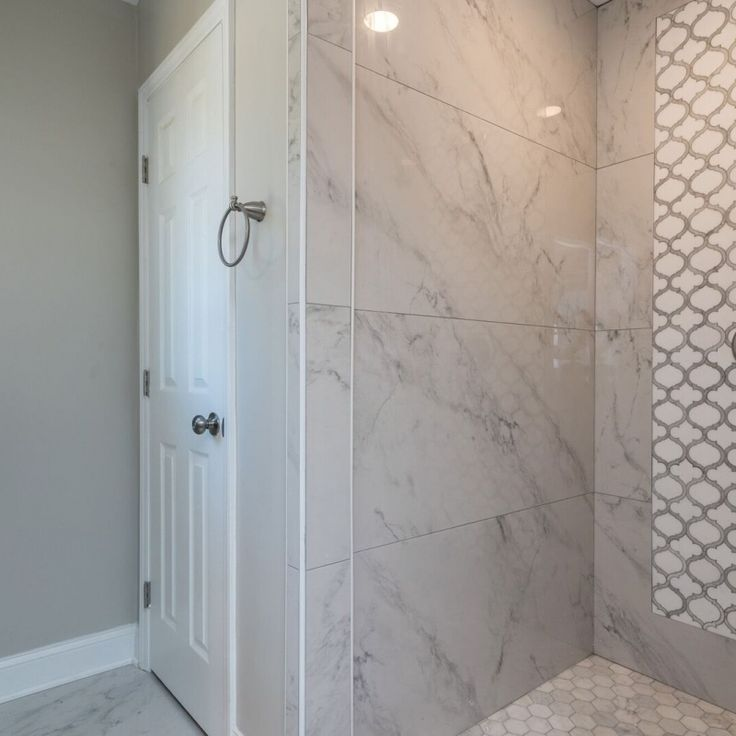
Smaller showers often feel cramped because of excess grout lines and tile interruptions. Switching to large-format tiles reduces visual segmentation, making walls appear wider and ceilings feel higher. These oversized slabs—often available in 24”x48” dimensions or larger—create a nearly seamless look that lends itself well to contemporary and modern styles. They’re especially effective in creating the illusion of a larger footprint when installed horizontally across walls or vertically to extend height. Materials like porcelain, natural stone, and marble-look finishes are particularly popular choices in 2025 for their durability and low maintenance. Beyond aesthetics, fewer grout joints also mean less cleaning and less chance of mold buildup. Pinterest users are increasingly saving large-tile shower inspirations due to their upscale vibe and practicality. Whether working with earthy tones, glossy finishes, or textured neutrals, the right tile choice can shift the room from tight to timeless. This design trick blends ease with elegance.
Gingham and Plaid Tiles

Charming and unexpected, gingham or plaid patterns offer a nostalgic twist to the modern small shower. These patterns, rooted in vintage aesthetics, are making a bold return in 2025 bathroom trends. Think muted blues, soft terracottas, or warm grays arranged in crosshatch or checkered layouts across a single accent wall or floor. Their symmetry brings balance to tight spaces, while the pattern creates a sense of energy and warmth. Best applied with matte-finish tiles to avoid harsh glare in confined areas, gingham works particularly well with white grout for crisp contrast. For homeowners who crave personality without overwhelming the space, this is a playful yet polished option. With interest in “plaid tile bathrooms” spiking across interior design boards on Pinterest, the look resonates especially well with farmhouse, cottagecore, and vintage-modern fans. When executed carefully, it becomes a signature feature that elevates a basic layout into something truly curated and conversation-worthy.
Full Paneling

Extending wall panels throughout the shower area lends a tailored and architectural feel to smaller bathrooms. Unlike tile, wall panels—such as beadboard, wood-look PVC, or moisture-resistant MDF—require fewer lines and offer a more continuous appearance. This uninterrupted flow reduces visual clutter and is easier to wipe down compared to traditional tile and grout. Vertical panels subtly elongate the space, while painted finishes in off-whites, sage, or muted charcoal help define the shower without overwhelming it. In 2025, paneling in compact showers has surged in popularity thanks to a growing appreciation for texture-rich, maintenance-friendly alternatives. Many DIYers and homeowners looking for “panel shower wall ideas” on Pinterest are opting for styles that reflect rustic or coastal charm. Installation is typically quicker and less messy than tiling, offering a quicker transformation for weekend projects. When designed with waterproof backing and clean lines, paneling becomes both a functional solution and a standout aesthetic element.
Curbless Showers
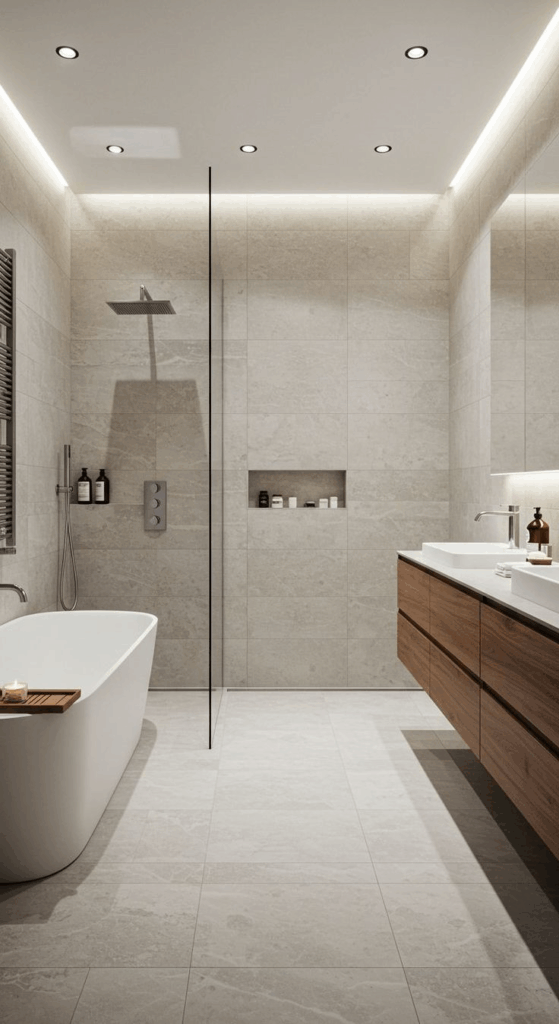
Removing the traditional curb at the shower base allows the flooring to continue seamlessly, promoting both accessibility and an open visual layout. This design is ideal for small bathrooms, as it minimizes visual boundaries and lets the eye travel across the space unobstructed. Popular in modern and Scandinavian-inspired homes, curbless showers work best with linear drains and subtly sloped floors for proper water drainage. Beyond its streamlined appearance, this setup supports aging-in-place and universal design needs, making it both stylish and practical. In high-traffic or family homes, the ease of entry becomes a standout benefit. Pinterest trends in 2025 show rising interest in “zero threshold showers” particularly for small spaces, spa-style remodels, and wet rooms. Finishes like continuous stone tile or concrete-look porcelain can amplify the effect. When executed correctly with professional-grade waterproofing, this design delivers longevity and minimalism in one clean sweep. It’s an investment that simplifies both form and function.
Wet Room Designs
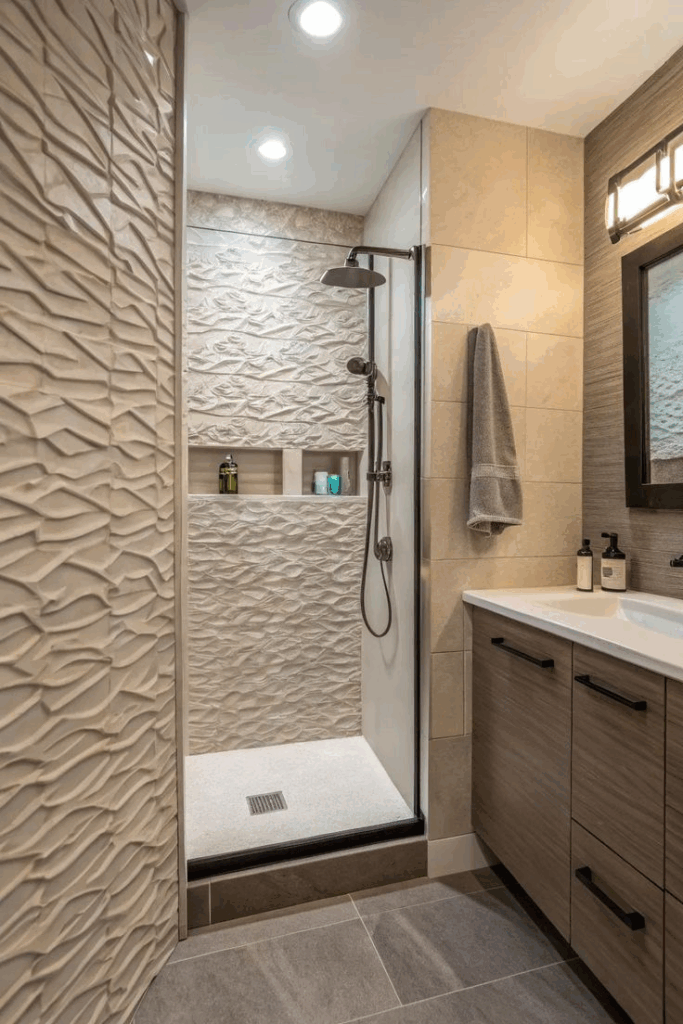
Blending the shower directly into the bathroom space without barriers defines the modern wet room approach. Ideal for very tight layouts, wet rooms remove the need for bulky shower enclosures, instead using smart floor grading and wall waterproofing to contain water flow. This layout improves usability while creating a seamless, resort-style feel—even in under-50-square-foot spaces. Popular materials include microcement, non-slip large tiles, and integrated linear drains. Glass partitions or half-walls can offer modest separation while preserving openness. More homeowners are saving “wet room small bathroom ideas” on Pinterest in 2025 due to the clean lines and clutter-free appeal. Wet rooms also offer accessibility advantages, making them appealing for multigenerational living. Pair the design with wall-mounted vanities and open shelves to avoid obstructing flow. With waterproofing being a key success factor, professional installation is crucial. When thoughtfully laid out, a wet room can make a cramped bathroom feel airy, functional, and sleek.
Integrated Storage Niches

Carving out recessed storage within the shower wall allows for streamlined organization without sacrificing square footage. These niches provide a home for shampoo bottles, soaps, and razors while eliminating the need for bulky caddies or shelves that intrude into the space. Available in various sizes and often lined with accent tiles for added flair, niches offer both convenience and design opportunity. Vertical niches are ideal in tighter stalls, while horizontal ones can span the width of the wall to store multiple items. Matching the niche trim with the tile material creates a seamless look, while contrasting patterns add visual interest. In 2025, “tile shower niche designs” have become increasingly popular across social platforms for their clean, functional beauty. Waterproofing and proper placement are essential to avoid water pooling. Whether minimalist or decorative, niches help reduce clutter and contribute to a cohesive, tailored appearance that supports a high-functioning, small-space bathroom layout.
Floating Vanities

Installing vanities that hover above the floor introduces visual airiness to small shower environments. These wall-mounted units free up valuable floor space, making the entire area feel less congested. The exposed underside allows light to flow beneath, which visually expands the room and enhances the sense of openness. Options range from sleek modern profiles in matte black or white oak to more rustic choices in reclaimed wood. In 2025, floating vanities with built-in drawers or minimalist open shelving are gaining attention on Pinterest as homeowners seek both style and function. When paired with under-cabinet lighting, these vanities double as a design feature and nighttime lighting solution. They also support easier cleaning and mopping underneath, which is especially valuable in tight layouts. For added cohesion, matching the vanity with nearby trim or mirror framing pulls the look together. This simple upgrade offers a modern, light-footprint solution for design-savvy small shower renovations.
Frameless Glass Enclosures
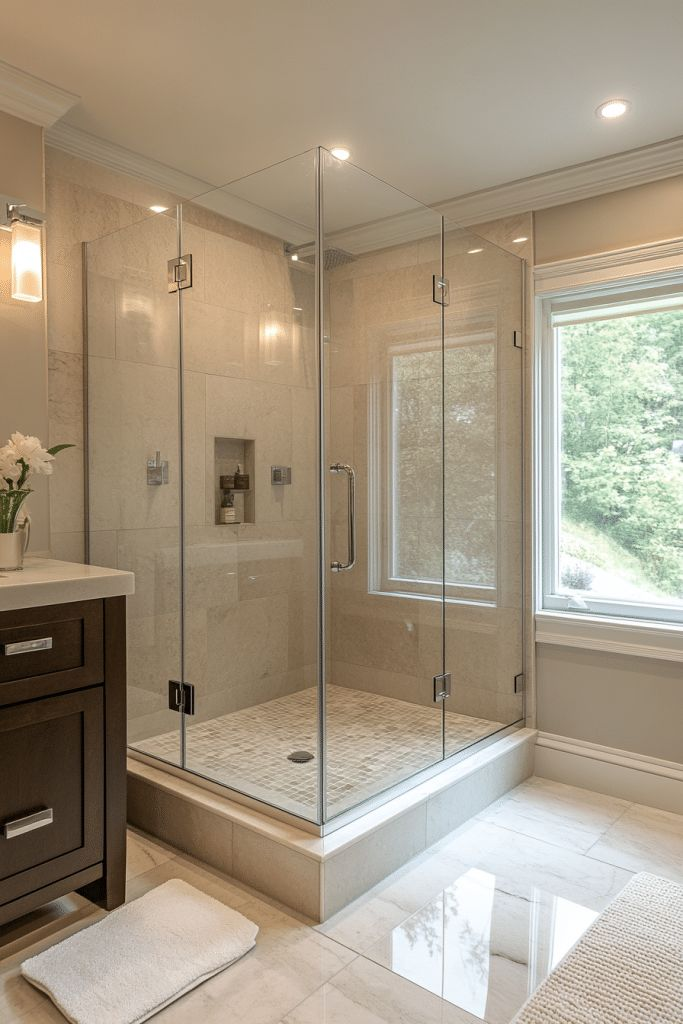
Opting for a frameless glass setup instantly removes visual interruptions and opens up even the tightest showers. With no metal edging to box in the area, the design invites light to pass freely, creating an airy, luxurious atmosphere. This layout is particularly effective in maximizing the perception of space when placed near windows or under skylights. Durable tempered glass, often with easy-clean coatings, makes maintenance low effort while maintaining clarity. Hinged doors or sliding tracks provide flexibility based on layout constraints. Frameless styles continue to trend on Pinterest for 2025, especially in minimalist, modern, and small-space bathroom designs. Pairing them with matching wall tiles and linear drains can amplify the spa-like effect. Proper installation is critical to avoid leaks and ensure stability. For homeowners looking to make their space feel high-end without expanding their footprint, this solution provides sleek aesthetics and unmatched light flow while maintaining full shower functionality.
Vertical Stripes
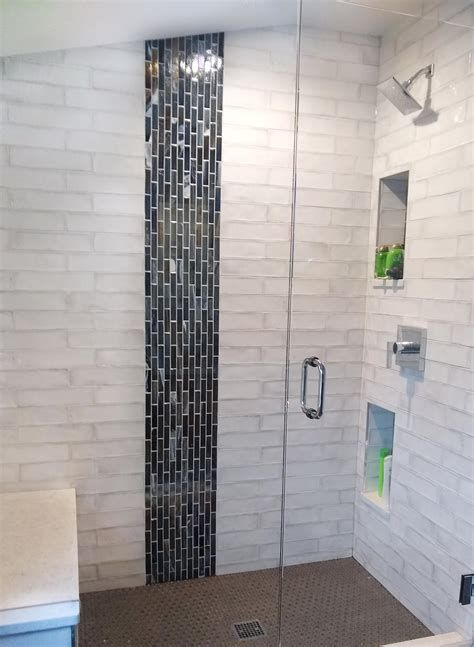
Utilizing vertical patterns in tile, wallpaper, or shower curtain designs can visually stretch the space upward, making a small shower feel significantly taller. Whether through slender subway tiles laid vertically, narrow mosaic arrangements, or striped curtain textiles, this technique is highly effective in creating dimension. It’s a visual illusion that brings a fresh perspective to confined layouts, especially in homes with low ceilings. Stripes in neutral palettes like white and taupe or soft pastels can add subtle elegance without overpowering the space. Pinterest search interest for “vertical bathroom tiles” has surged in 2025, reflecting a wider design trend focused on directional flow and space elongation. To avoid overwhelming the area, limit the pattern to one accent wall or feature area. This subtle trick works well in both traditional and modern settings. Clean lines, when oriented vertically, guide the eye upward, creating a sense of openness in even the smallest shower spaces.
Corner Vanities

When square footage is scarce, placing a vanity in the corner opens up precious walking room and keeps pathways clear. Corner vanities maximize dead zones while still providing sink access and storage—a win-win for tight bathrooms. Look for triangular or L-shaped units with built-in shelves or drawers to take advantage of every inch. Wall-mounted faucets can further save space and complement the design. Pinterest users are increasingly pinning “corner vanity small bathroom” ideas as they seek space-saving solutions without sacrificing style. These vanities work exceptionally well in conjunction with curved shower enclosures or wall-mounted toilets, allowing for smart circulation. Light-colored finishes like white oak or matte stone blend easily with small-space palettes. To maintain visual balance, pair a corner vanity with a rounded mirror or sconce lighting to soften angles. Efficient use of corners not only optimizes layout but helps create a more fluid, accessible design.
Translucent Shades

Letting in natural light while preserving privacy is essential in small showers, and translucent window shades strike that balance perfectly. Materials like frosted vinyl, woven polyester, or top-down cellular shades diffuse light beautifully without exposing the interior. In bathrooms with limited artificial lighting, this simple addition can brighten the shower area without requiring renovations. They’re especially effective for showers near exterior walls or bathroom windows, allowing sunlight to enter while shielding the view. Homeowners are increasingly turning to these shades in 2025, particularly as interest in “light-diffusing bathroom treatments” grows on platforms like Pinterest. Mounting options include inside-frame or ceiling-mounted hardware to maintain clean lines. Choose neutral or soft tones that complement existing tiles or cabinetry for a cohesive finish. Beyond visual benefits, these shades can also improve ventilation when paired with operable windows, making the space more comfortable and less prone to mildew. It’s a functional fix with gentle impact.
Personalized Monogrammed Curtains

Tailoring a shower curtain with initials, embroidery, or stitched motifs adds personality without compromising functionality. Custom curtains turn a utilitarian element into a design feature, especially in guest bathrooms or primary suites. When executed with restraint—such as tonal embroidery or elegant font choices—monograms add a boutique-hotel feel to compact spaces. Linen blends or cotton-polyester materials with mildew resistance are ideal for maintaining freshness and durability. In 2025, there’s a rise in searches for “custom shower curtains” as homeowners look for ways to individualize even the smallest spaces. Pairing monogrammed designs with minimalist accessories or matching towels helps anchor the look. It’s an especially popular upgrade in rental properties where permanent changes are off-limits. Aside from their charm, custom curtains make great conversation starters and can reflect household personality in a subtle, thoughtful way. Simple, timeless, and highly personal, this detail adds character without crowding the room or breaking the budget.
Vintage Statement Pieces

Reimagining a small shower with vintage elements can instantly bring character and uniqueness. Think antique brass fixtures, an old-world mirror above the sink, or a reclaimed wood stool tucked near the corner. These touches infuse history into the space and contrast beautifully with modern finishes like frameless glass or white tile. Even a vintage coat hook or ornate sconce can functionally and aesthetically upgrade the room. Pinterest users in 2025 are gravitating toward “antique bathroom details” as part of the broader move toward layered, personalized interiors. Carefully selected vintage finds often carry better craftsmanship and can act as the visual anchor in minimalist surroundings. To prevent the space from feeling cluttered, balance ornate pieces with streamlined materials and neutral palettes. This approach keeps the focus on one or two standout elements. Vintage styling is more than aesthetic—it introduces storytelling into the design, making small bathrooms feel curated and soulful.
